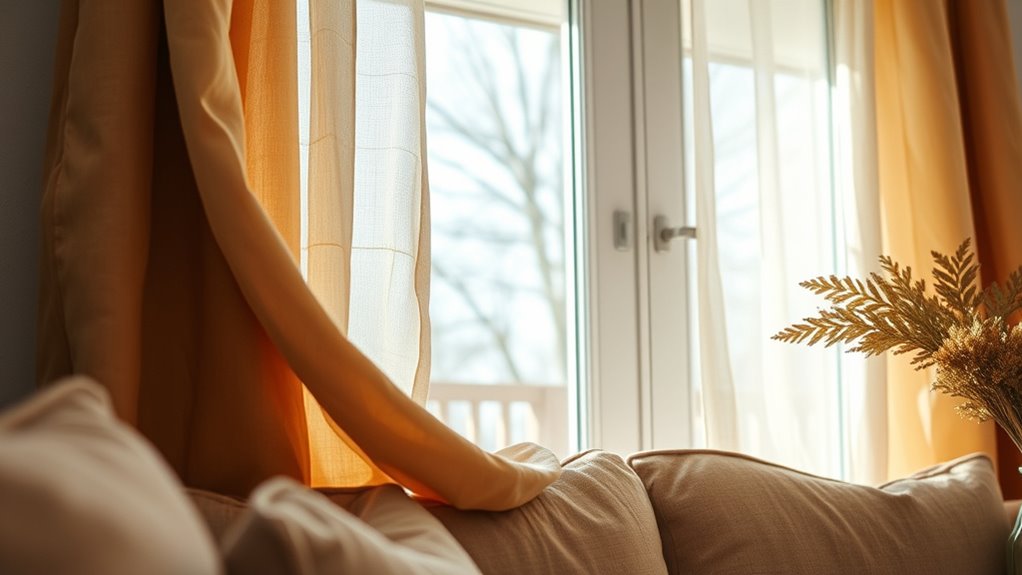To lower your home’s temperature and save energy, DIY thermal curtains are a smart solution. Choose thick, layered fabrics like polyester or wool blends, and sew precise seams to prevent drafts. Use insulating materials such as reflective foil or foam behind the fabric, and hang your curtains close to the wall and floor for maximum coverage. Properly installed curtains can block cold air and keep heat in. Keep exploring to discover tips for creating effective thermal curtains that make a real difference.
Key Takeaways
- Use thick, insulating fabrics like polyester or wool blends to block cold air effectively.
- Sew double hems and secure layers to prevent drafts and improve thermal retention.
- Incorporate reflective foil or thermal lining behind the fabric for added heat bounce-back.
- Hang curtains close to the wall and ensure they extend beyond window edges for maximum insulation.
- Measure and cut fabric precisely, using sturdy stitches to create a snug, draft-proof fit.

Are you looking for a simple way to keep your home warmer and cut down on energy bills? DIY thermal curtains are an excellent solution. They’re affordable, easy to make, and can considerably improve your home’s insulation. The key lies in selecting the right insulation materials and mastering some basic sewing techniques, both of which can make your curtains highly effective at blocking drafts and heat loss.
Start by choosing the right insulation materials. Thick, dense fabrics like polyester or heavyweight cotton work well, but for added insulation, consider using thermal lining or insulating foam behind your curtain fabric. You can also layer different materials—adding a layer of reflective foil between fabric layers can bounce heat back into your room, making your curtains even more efficient. When shopping for insulation materials, look for options that are breathable yet capable of trapping air, like quilted fabrics or wool blends. These materials help reduce heat transfer through your windows, keeping the cold out and warmth in.
Choose breathable, insulated fabrics like thermal lining or quilted materials for effective DIY thermal curtains.
Once you have your materials, focus on your sewing techniques. Precision matters, so take your time measuring and cutting your fabric pieces. Use straight seams to prevent gaps where cold air might slip through, and consider adding a top hem with a pocket for a curtain rod that allows for a snug fit. Sewing a double hem at the bottom can also help prevent drafts from sneaking underneath. To maximize insulation, sew the layers together securely, ensuring there are no loose or uneven stitches that could create gaps. If you’re adding insulation layers, baste them in place before sewing the final seams for a smooth, even finish. Incorporating insulation materials that are designed for thermal efficiency can further enhance your curtains’ insulating properties.
Hemming your curtains properly is essential. A longer, heavier curtain fabric can help block more cold air, but it also needs to be easy to draw closed. Use sturdy thread and double stitching at stress points to ensure longevity. If you’re comfortable with sewing, consider adding pleats or tabs for a more polished look and better coverage. These small details can make a big difference in how well your curtains insulate your windows.
Finally, hanging your thermal curtains correctly is just as important as making them. Use a sturdy curtain rod that extends beyond the window frame to prevent drafts from sneaking around the edges. The curtains should be close to the wall and floor to maximize their insulating effect. With a little effort and some basic sewing skills, you can craft DIY thermal curtains that keep your home warmer and reduce your energy bills, all while adding a cozy, personalized touch to your space.
Frequently Asked Questions
How Long Does It Take to Make Thermal Curtains?
Making thermal curtains typically takes about 3 to 6 hours, depending on your fabric selection and sewing techniques. If you choose thicker or layered fabrics, it might take a bit longer. You’ll want to spend time measuring and cutting accurately, then sewing carefully to guarantee they insulate well. With some patience and practice, you can complete your project efficiently, turning your fabric into energy-saving curtains in just a day.
Can DIY Thermal Curtains Be Machine Washable?
You can make DIY thermal curtains machine washable, but it depends on the fabric you choose. Opt for durable fabrics like cotton or polyester blends, which handle washing well. Always follow the specific washing instructions provided by the fabric manufacturer to maintain fabric durability. Proper care guarantees your curtains stay effective and look good over time, making them a practical and energy-saving addition to your home.
What Materials Are Best for DIY Thermal Curtains?
You’re really on to something if you want effective DIY thermal curtains. The best materials combine good fabric insulation with a sturdy curtain lining, such as heavyweight cotton, fleece, or thermal polyester. These materials trap heat and block drafts effectively. Think of it as giving your windows a cozy blanket. Choosing layered fabrics guarantees your curtains are both functional and durable, helping you save energy while adding a touch of style.
Do Thermal Curtains Block Out All Light?
Thermal curtains can block a significant amount of light, but they usually don’t block out all of it. Light blocking depends on your fabric choices; heavier, dense fabrics like blackout or tightly woven materials provide better light blocking. If you want complete darkness, consider adding blackout linings or choosing curtains specifically labeled as blackout. Keep in mind, your fabric choices play a vital role in how much light your thermal curtains will block.
How Effective Are DIY Thermal Curtains in Different Climates?
Imagine a cozy blanket wrapping your home—DIY thermal curtains can do that, but their climate adaptability varies. In colder regions, they boost insulation efficiency, helping retain heat and cut energy costs. In milder climates, they still provide some barrier but may be less impactful. Their effectiveness depends on your specific environment, so tailoring your curtains to your climate guarantees you get the best energy savings and comfort.
Conclusion
Ditch drafts, diminish drafts, and definitely delight in DIY thermal curtains. By building barriers that block breezes and bolster barriers, you’ll beautifully balance your home’s heat and happiness. With simple sewing skills and savvy strategies, you’ll save markedly on heating costs, stay snug and serene, and succeed in sealing your space against the chilly, costly chaos outside. Turn down the thermostat, and transform your home into a cozy, cost-conscious haven with your own crafted curtains.









